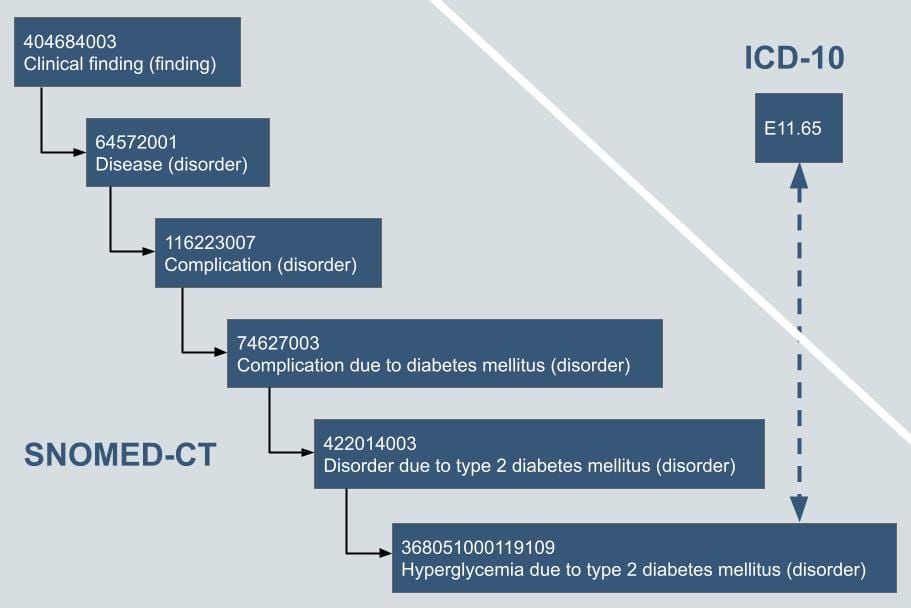 SNOMED and ICD-10 are two of several sets of codes used to describe diagnoses and treatments in healthcare. Why do multiple sets of codes exist? Because each addresses a different set of use cases within healthcare.
SNOMED and ICD-10 are two of several sets of codes used to describe diagnoses and treatments in healthcare. Why do multiple sets of codes exist? Because each addresses a different set of use cases within healthcare.
This post will give an overview of the SNOMED terminologies and ICD-10 classifications as we look at ways to normalize data between the two sets.
Accurately normalizing data across these disparate code sets is important to providers, patients, and payers. Incorrect coding or coding that is not specific enough can result in claim denials. Accurate mapping would be a challenge even if these code sets never changed. A number of factors cause them to, however, including:
- New diagnoses, such as “contact with and (suspected) exposure to SARS-CoV-2”
- The upcoming version 11 of ICD
- Changing interoperability requirements as mandated by Federal agencies
SNOMED CT – Diagnosis and Treatment
SNOMED CT stands for Systematized Nomenclature of Medicine – Clinical Terms. It’s the terminology for the diagnostic and treatment side of healthcare.
SNOMED CT and its predecessors have been in use in the US since 1965. As of January 2020, the terminology set documented 352,567 concepts. These concepts are hierarchical, organized in parent/child relationships. Assigning a SNOMED code is usually automated and not as visible to end users as ICD-10.
The following multi-generational references are ours. The number next to each is the concept code. You can see in this example that “Hyperglycemia due to type 2 diabetes mellitus (disorder)” is a great great great grandchild of “Clinical finding (finding).”
- Parent: Clinical finding (finding) – 404684003
- Child: Disease (disorder) – 64572001
- Grandchild: Complication (disorder) – 116223007
- Great Grandchild: Complication due to diabetes mellitus (disorder) – 74627003
- Great Great Grandchild: Disorder due to type 2 diabetes mellitus (disorder) – 422014003
- Great Great Great Grandchild: Hyperglycemia due to type 2 diabetes mellitus (disorder) – 368051000119109
SNOMED is not just a coding system of diagnosis—it covers other types of clinical findings like signs and symptoms and includes tens of thousands of surgical, therapeutic, and diagnostic procedures in addition to observables, such as heart rate. According to SNOMED, “it also includes concepts representing body structures, organisms, substances, pharmaceutical products, physical objects, physical forces, specimens and many other types of information that may need to be recorded in or around a health record.”
ICD-10 – Reimbursements and Analytics
ICD stands for International Classification of Diseases. It is the standardized terminology for billing codes and has existed in one form or another since 1900. Its use in the United States began in 1968 and is managed by the World Health Organization.
The current version, ICD-10, has over 70,000 codes. Those codes are assigned by professional medical coders, not an automated system as with SNOMED.

ICD has two major groupings, ICD-10-CM and ICD-10-PCS. /ICD-10-CM is the code set for diagnoses. ICD-10-PCS is used in hospital inpatient settings for inpatient procedure coding. As evidence of the constant change referenced above, 577 codes were added to the 2021 ICD-10-PCS code set.
ICD-10 was introduced in 1992. According to SoftwareAdvice, it took the US 23 years to completely transition to it. Now, only a few years after the completion, version 11 is scheduled to take effect in January 2022.
Codes will differ substantially between versions 10 and 11. Take Alzheimer’s disease, for instance. In version 10, the code is G30. In version 11, it’s 8A20.
The new version of ICD is a digital, multilingual product. It contains six major extensions called chapters. As with the transition from ICD-9 to ICD-10, payers will have to be ready to process claims with ICD-11 codes for medical diagnoses and inpatient procedures.
Why Is Coding So Complex?
One way to look at the root of the complexity is the fact that there are multiple dimensions, each with its own set of sub-dimensions.
Clinical Findings
Above, we followed just one example of a SNOMED hierarchical path for diabetes. The disease has many dimensions, however, including:
- Multiple origins (genetics, lifestyle, other medical conditions)
- Multiple symptoms or impacts (infections, nerve pain in feet and legs, blurred vision)
- Multiple treatments (drugs, devices, procedures, operations)
The dimensions create a large number of branches in each hierarchy.
Healthcare Software Systems
Codes have to be mapped among IT systems at different points along the care continuum. Systems include:
- HIEs
- EHRs
- Billing
- Data warehouses
- CRM
- Other systems
HIE Participants
Codes within patient records need to be communicated among many different HIE participants, magnifying the complexity of mapping across IT systems. Such participants include:
- Hospitals & health systems
- Community health providers
- Labs
- Imaging centers
- Pharmacies
- Long term care providers
- Behavioral health providers
These dimensions and sub-dimensions add up to many data consistency challenges.
Compliance with Federal Mandates
The U.S. Centers for Medicare and Medicaid Services (CMS) has mandated a July 2021 deadline for health insurers to make electronic patient data available through an application for their members, such as a smartphone app.
Tied to this interoperability mandate is the need to normalize the terminologies and classifications that are used across different functional areas within a health system.
SNOMED to ICD Mapping Options
For many organizations, performing the data mapping between ICD and SNOMED has historically been done in one of two ways.
One approach has been using large spreadsheets—thousands of columns and tens of thousands of cells. These files have multiple owners, and there are complex and maintenance and update procedures. It is labor-intensive to manage and update.
Human error, in addition, can produce a negative ripple effect. Just one deleted cell can throw off thousands of spreadsheet rows. Furthermore, because traditional Excel spreadsheets are non-collaborative documents that are passed around from person to person, it’s easy for someone to end up with an outdated or incorrect version of the document. Spreadsheet alternatives such as Google Sheets and Smartsheet solve the collaboration problem, but they don’t solve ripple-effect issues.

The other approach for SNOMED to ICD mapping has been custom on-premises solutions. These require dedicated IT resources to implement and manage. They are also expensive to purchase.
Fortunately, there’s an easier and less expensive solution.
Terminology Management for SNOMED-CT and ICD-10
Managed Terminology provides a fully managed environment in the cloud for maintaining current libraries of multiple medical coding systems like SNOMED CT and ICD and the translation between them.
With a cloud environment, there is a single, consistent source of information across the enterprise. It is a more economical and efficient alternative to managing large spreadsheets or using custom, on-premise solutions.




